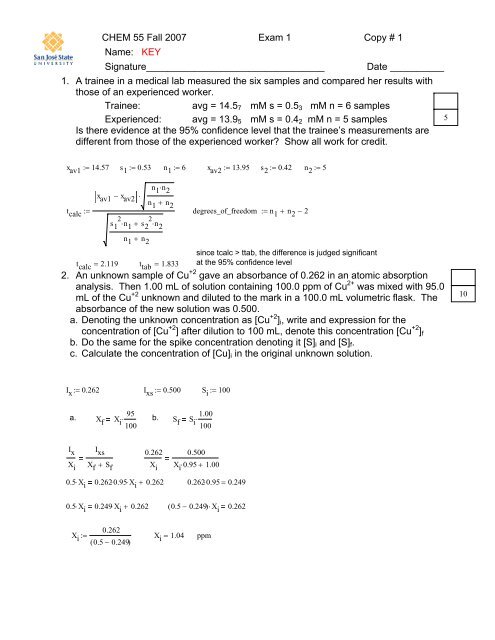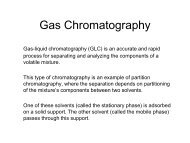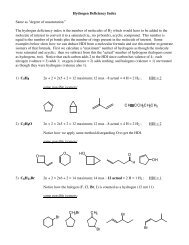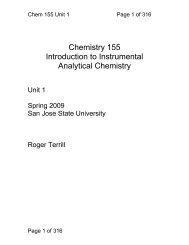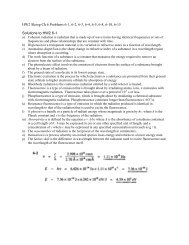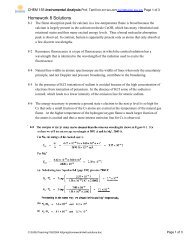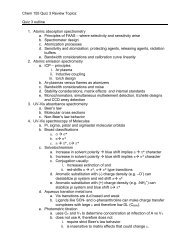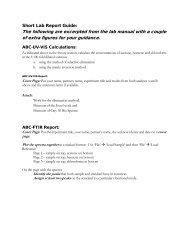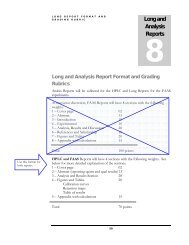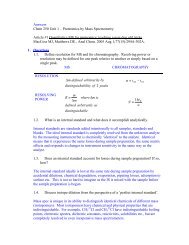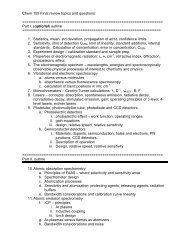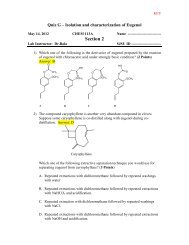Chem 55 Exam 2 Solutions
Chem 55 Exam 2 Solutions
Chem 55 Exam 2 Solutions
You also want an ePaper? Increase the reach of your titles
YUMPU automatically turns print PDFs into web optimized ePapers that Google loves.
CHEM <strong>55</strong> Fall 2007 <strong>Exam</strong> 1 Copy # 1<br />
Name: KEY<br />
Signature_________________________________ Date __________<br />
1. A trainee in a medical lab measured the six samples and compared her results with<br />
those of an experienced worker.<br />
Trainee:<br />
avg = 14.5 7 mM s = 0.5 3 mM n = 6 samples<br />
Experienced: avg = 13.9 5 mM s = 0.4 2 mM n = 5 samples<br />
Is there evidence at the 95% confidence level that the trainee’s measurements are<br />
different from those of the experienced worker Show all work for credit.<br />
5<br />
x av1 := 14.57 s 1 := 0.53 n 1 := 6 x av2 := 13.95 s 2 := 0.42 n 2 := 5<br />
n 1 ⋅n 2<br />
x av1 − x av2 ⋅<br />
n 1 + n 2<br />
t calc := degrees_of_freedom := n 1 + n 2 − 2<br />
2<br />
s 1 ⋅ n1<br />
+<br />
n 1 + n 2<br />
2<br />
s 2 ⋅ n2<br />
t calc = 2.119 t tab = 1.833<br />
since tcalc > ttab, the difference is judged significant<br />
at the 95% confidence level<br />
2. An unknown sample of Cu +2 gave an absorbance of 0.262 in an atomic absorption<br />
analysis. Then 1.00 mL of solution containing 100.0 ppm of Cu 2+ was mixed with 95.0<br />
mL of the Cu +2 unknown and diluted to the mark in a 100.0 mL volumetric flask. The<br />
absorbance of the new solution was 0.500.<br />
a. Denoting the unknown concentration as [Cu +2 ] i , write and expression for the<br />
concentration of [Cu +2 ] after dilution to 100 mL, denote this concentration [Cu +2 ] f<br />
b. Do the same for the spike concentration denoting it [S] i and [S] f .<br />
c. Calculate the concentration of [Cu] i in the original unknown solution.<br />
10<br />
I x := 0.262<br />
I xs := 0.500 S i := 100<br />
95<br />
1.00<br />
a. X f X i ⋅ b. S<br />
100<br />
f S i ⋅<br />
100<br />
I x<br />
X i<br />
I xs<br />
X f + S f<br />
0.262 0.500<br />
X i X i ⋅0.95<br />
+ 1.00<br />
0.5⋅ X i 0.262⋅<br />
0.95⋅ X i + 0.262 0.262⋅ 0.95 = 0.249<br />
0.5⋅<br />
X i<br />
0.249⋅ X i + 0.262 ( 0.5 − 0.249) ⋅ X i 0.262<br />
0.262<br />
X i := X<br />
( 0.5 − 0.249)<br />
i = 1.04 ppm
CHEM <strong>55</strong> Fall 2007 <strong>Exam</strong> 1 Copy # 1<br />
Name: Au,Hai Nguyen<br />
3. Calculate the molarity of La(IO 3 ) 3 at saturation in water (K SP (La(IO 3 ) 3 = 1.0x10 -11 ).<br />
Ksp<br />
⎛<br />
⎜<br />
⎝<br />
x⋅ ( 3x) 3 27x 4 x<br />
1.0⋅<br />
10 − 11<br />
27<br />
⎞<br />
⎟<br />
⎠<br />
1<br />
4<br />
⎛<br />
⎜<br />
⎝<br />
Ksp<br />
27<br />
⎞ ⎟⎠<br />
1<br />
4<br />
= 7.801×<br />
10 − 4 = [La+3]<br />
5<br />
4. Calculate the molarity of La(IO 3 ) 3 at saturation in water containing 0.050 M LiIO 3 given<br />
K SP (LaIO 3 ) = 1.0x10 -11 .<br />
Ksp x⋅<br />
0.050 3<br />
1.0⋅<br />
10 − 11<br />
= 8×<br />
10 − 8 = [La+3]<br />
0.050 3<br />
5<br />
5. Repeat the above calculation but including the effects of ion activity and given that the<br />
ionic radius of La +3 is 900 pm and that of IO 3 - is 450 pm.<br />
5<br />
− 0.51⋅z 2 ⋅ μ<br />
1+<br />
α⋅ μ<br />
305<br />
z:= 3 α := 900<br />
γLa := 10<br />
γLa = 0.24<br />
− 0.51⋅z 2 ⋅ μ<br />
1+<br />
α⋅ μ<br />
305<br />
z:= −1<br />
α := 405<br />
γIO3 := 10<br />
γIO3 = 0.82<br />
Ksp<br />
x⋅ γLa⋅0.050 3 ⋅γIO3 3<br />
1.0⋅<br />
10 − 11<br />
0.050 3 ⋅γIO3 3 ⋅γLa<br />
= 6.1 × 10 − 7 = [La+3]
CHEM <strong>55</strong> Fall 2007 <strong>Exam</strong> 1 Copy # 1<br />
Name: Au,Hai Nguyen<br />
6. A solution of NaOH was standardized by titration of a known quantity of the primary<br />
standard potassium hydrogen phthalate (KHP, FM 204.221 g/mol).<br />
a. Titration of 0.824 g of potassium hydrogen phthalate required 38.314 mL of NaOH to<br />
reach the endpoint detected by phenolphthalein. Find the concentration of NaOH in<br />
molarity (M).<br />
10<br />
mol⋅<br />
KHP<br />
0.824⋅<br />
g⋅<br />
⋅<br />
204.221g ⋅ ⋅KHP<br />
1⋅<br />
NaOH<br />
1⋅KHP<br />
⋅<br />
1<br />
=<br />
38.31410 ⋅<br />
− 3 ⋅L⋅<br />
NaOH<br />
mol NaOH<br />
0.105 ⋅ L<br />
b. A 100.00 mL aliquot of H 2 SO 4 solution required 57.911 mL of the NaOH solution to<br />
reach the endpoint. Calculate the concentration of the H 2 SO 4 .<br />
5<br />
57.91110 ⋅<br />
− 3 0.1053mol ⋅ ⋅ NaOH 1⋅H2SO4<br />
1<br />
⋅L⋅<br />
NaOH⋅<br />
⋅ ⋅<br />
=<br />
L⋅<br />
NaOH 2⋅<br />
NaOH<br />
100.0⋅<br />
10 − 3 ⋅L⋅<br />
H2SO4<br />
mol H2SO4<br />
0.0305 ⋅ L
CHEM <strong>55</strong> Fall 2007 <strong>Exam</strong> 1 Copy # 1<br />
Name: Au,Hai Nguyen<br />
7. How many milliliters of 0.100 M KI are needed to react with 40.0 mL of 0.0400 M<br />
Hg 2 (NO 3 ) 2 if the reaction is Hg 2 2+ + 2I - Hg 2 I 2 (s)<br />
5<br />
40.0⋅<br />
10 − 3<br />
mol⋅<br />
Hg2NO32 2KI ⋅ 1L ⋅ ⋅KI<br />
⋅L⋅ Hg2NO32⋅<br />
0.0400⋅<br />
⋅ ⋅<br />
=<br />
L⋅<br />
Hg2NO32 Hg2NO32 0.100⋅<br />
mol⋅<br />
KI<br />
0.0320L⋅<br />
KI<br />
8.<br />
a. Find the activity coefficient of H + in a solution containing 0.010 M HCl plus 0.040 M<br />
KClO 4 . (H + = 900 pm)<br />
5<br />
0.010⋅ 1 2 + 0.010⋅( −1) 2 + 0.040⋅<br />
1 2 + 0.040⋅( −1) 2<br />
μ := μ = 0.050<br />
2<br />
− 0.51⋅z 2 ⋅<br />
1+<br />
α⋅<br />
μ<br />
305<br />
z:= 1 α := 900<br />
γH:= 10<br />
γH = 0.85<br />
μ<br />
b. What is the pH of this solution<br />
5<br />
( )<br />
pH := −log 0.010⋅<br />
γH pH = 2.069
CHEM <strong>55</strong> Fall 2007 <strong>Exam</strong> 1 Copy # 1<br />
Name: Au,Hai Nguyen<br />
Values of Student's t<br />
% confidence interval<br />
°freedom 50 80 95 99<br />
1 1.00 3.08 12.71 63.66<br />
2 0.82 1.89 4.30 9.92<br />
3 0.76 1.64 3.18 5.84<br />
4 0.74 1.53 2.78 4.60<br />
5 0.73 1.48 2.57 4.03<br />
6 0.72 1.44 2.45 3.71<br />
7 0.71 1.41 2.36 3.50<br />
8 0.71 1.40 2.31 3.36<br />
9 0.70 1.38 2.26 3.25<br />
10 0.70 1.37 2.23 3.17<br />
20 0.69 1.33 2.09 2.85<br />
50 0.68 1.30 2.01 2.68<br />
100 0.68 1.29 1.98 2.63<br />
∞ 0.67 1.28 1.96 2.58<br />
Values of Q for rejection of data:<br />
Q<br />
90% confidence<br />
Number of<br />
Observations<br />
0.76 4<br />
0.64 5<br />
0.56 6<br />
0.51 7<br />
0.47 8<br />
0.44 9<br />
0.41 10<br />
Average, Sample standard deviation<br />
and confidence interval formulae:<br />
x =<br />
n<br />
∑<br />
i=<br />
1<br />
n<br />
n<br />
x<br />
∑<br />
( xi<br />
− x)<br />
i=<br />
1<br />
s =<br />
n −1<br />
CI = x ±<br />
ts<br />
n<br />
( x − μ)<br />
t =<br />
s<br />
i<br />
n<br />
2<br />
Error propagation formulae:<br />
for : y = x1<br />
+ x2<br />
for : y = x1⋅<br />
x2<br />
for : y = log( x)<br />
for : y = 10<br />
for : y = ln( x)<br />
for : y = e<br />
for : y = x<br />
x<br />
a<br />
x<br />
e<br />
e<br />
y<br />
y<br />
% e<br />
y<br />
e<br />
y<br />
% e<br />
y<br />
=<br />
=<br />
ex<br />
ey<br />
=<br />
x<br />
= y ⋅e<br />
x<br />
e<br />
2<br />
x1<br />
= a ⋅%<br />
e<br />
% e<br />
x<br />
+ e<br />
2<br />
x1<br />
ex<br />
ey<br />
= 0.434<br />
x<br />
= 2.303⋅<br />
y ⋅e<br />
x<br />
2<br />
x2<br />
+ % e<br />
2<br />
x2
CHEM <strong>55</strong> Fall 2007 <strong>Exam</strong> 1 Copy # 1<br />
Name: Au,Hai Nguyen<br />
For standard additions:<br />
I<br />
X<br />
I<br />
S + X<br />
=<br />
[ X ] [ X ] + [ S]<br />
where<br />
[ X ]<br />
[ S]<br />
f<br />
i<br />
f<br />
f<br />
Vx<br />
= [ X ]<br />
i<br />
and<br />
V<br />
VS<br />
= [ S]<br />
i<br />
V<br />
f<br />
For Internal Standads:<br />
AX<br />
AS<br />
= F<br />
[ X ] [ S]<br />
where<br />
A<br />
A<br />
X<br />
S<br />
= Sample Signal<br />
= Internal S tan dard<br />
Signal<br />
Detection Limit:<br />
3s<br />
Cm<br />
=<br />
m<br />
and<br />
y<br />
DL<br />
= y<br />
BLANK<br />
+ 3s<br />
Spike Recovery<br />
C<br />
% recovery<br />
=<br />
spiked sample<br />
C<br />
− C<br />
added<br />
unspiked sample<br />
Ion activity in general:<br />
for<br />
aA + bB ↔ cC + dD<br />
K<br />
EQ<br />
c c d d<br />
[ C]<br />
γ<br />
C[<br />
D]<br />
γ<br />
D<br />
=<br />
a a b b<br />
[ A]<br />
γ [ B]<br />
γ<br />
A<br />
B<br />
pH<br />
= −log[<br />
H<br />
+<br />
] γ<br />
H +<br />
Ion activity coefficient:<br />
2<br />
− 0.51z<br />
μ<br />
log( γ ) =<br />
α μ<br />
1 +<br />
305<br />
Ionic strength:<br />
1<br />
μ =<br />
2<br />
∑<br />
i<br />
Ci z 2<br />
i


